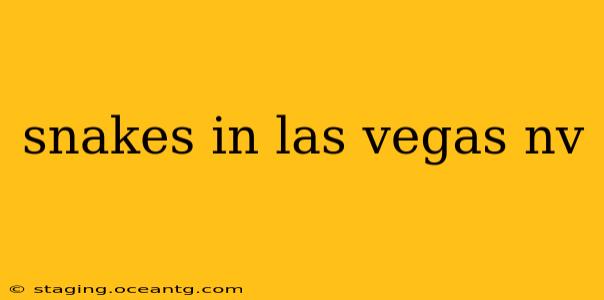Las Vegas, with its sprawling desert landscape and diverse ecosystems, is home to a variety of snake species. While the city itself is heavily developed, snakes can still be found in bordering natural areas and even occasionally venture into urban spaces. Understanding which snakes inhabit the area and how to react to encounters is crucial for both residents and visitors. This comprehensive guide will explore the different types of snakes found in and around Las Vegas, addressing common concerns and safety precautions.
What types of snakes are found in Las Vegas?
Las Vegas and its surrounding areas are home to several species, ranging from harmless to venomous. Some of the most common include:
-
Great Basin Gophersnake ( Pituophis catenifer deserticola): This large, non-venomous snake is often mistaken for a rattlesnake due to its size and coloration. It plays a vital role in controlling rodent populations.
-
Desert Spiny Lizard ( Sceloporus magister): While technically a lizard, it's frequently confused with snakes. It is harmless to humans.
-
Western Diamondback Rattlesnake (Crotalus atrox): This is the most dangerous snake in the Las Vegas area. It's large, with a distinctive diamond pattern and a characteristic rattle.
-
Sidewinder Rattlesnake (Crotalus cerastes): Known for its unique sidewinding locomotion, this rattlesnake is also venomous but generally smaller than the Western Diamondback.
-
Coachwhip Snake (Masticophis flagellum): A long, slender, non-venomous snake, often swift-moving.
Are snakes in Las Vegas dangerous?
While most snakes in the Las Vegas area are harmless, encountering a venomous species like the Western Diamondback or Sidewinder rattlesnake presents a serious risk. These snakes will only strike if they feel threatened, so it's crucial to give them a wide berth. The venom of these rattlesnakes is medically significant and requires immediate medical attention.
What should I do if I see a snake in Las Vegas?
The best course of action is to leave it alone. Do not attempt to handle or kill the snake. Most snake bites occur when people try to capture or interact with the snake. Observe the snake from a safe distance and slowly back away. If you feel threatened or are unsure about the snake's identity, contact animal control or a qualified wildlife removal service.
How can I prevent snakes from entering my property?
Preventing snakes from entering your property involves several steps:
- Seal cracks and gaps: Snakes can squeeze through surprisingly small openings in foundations, walls, and around pipes.
- Maintain landscaping: Keep grass trimmed short and remove brush piles where snakes might hide.
- Secure trash cans: Remove attractants such as rodents by properly storing food and garbage.
- Remove debris: Clear away rocks, woodpiles, and other items that provide shelter for snakes.
What is the most common snake in Las Vegas?
While the Western Diamondback Rattlesnake is perhaps the most feared, the Great Basin Gophersnake is likely more common in terms of sheer numbers encountered. Its size and appearance often lead to misidentification as a venomous species.
Are there venomous snakes in Las Vegas?
Yes, venomous snakes, specifically the Western Diamondback and Sidewinder rattlesnakes, are present in the Las Vegas area. They pose a significant threat, and caution is advised when venturing into natural areas.
What should I do if I am bitten by a snake in Las Vegas?
A snakebite is a medical emergency. Remain calm, seek immediate medical attention, and if possible, try to note the snake's appearance (photo if safe to do so, but prioritize your safety) to help medical professionals administer the appropriate treatment. Do not attempt to apply a tourniquet or cut the wound.
This information is for educational purposes only and should not be considered a substitute for professional advice. Always consult with qualified professionals for any snake-related concerns or emergencies. Remember, responsible coexistence with wildlife is key to enjoying the natural beauty of the Las Vegas area.
